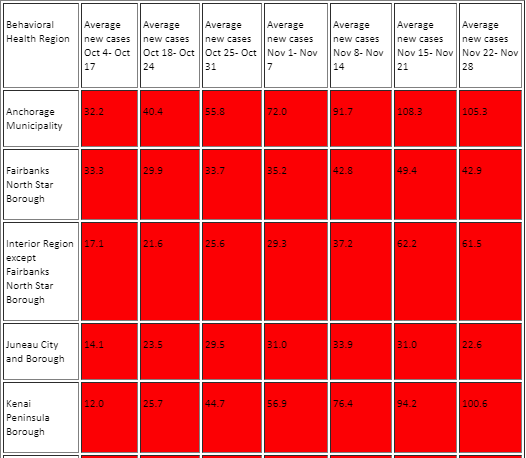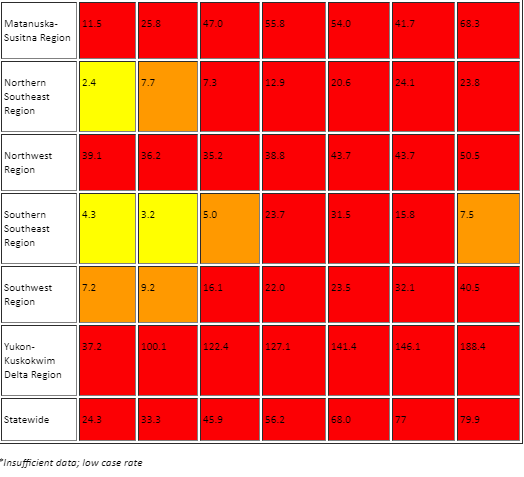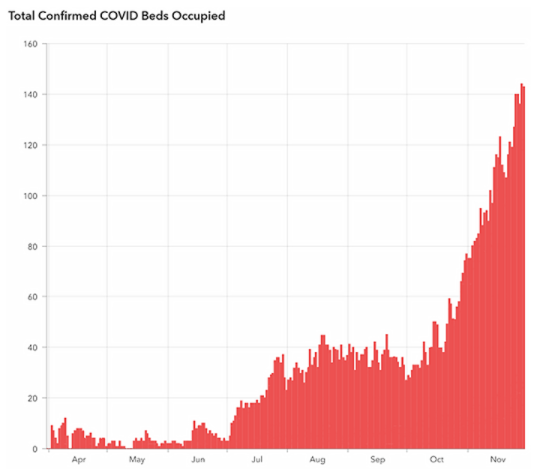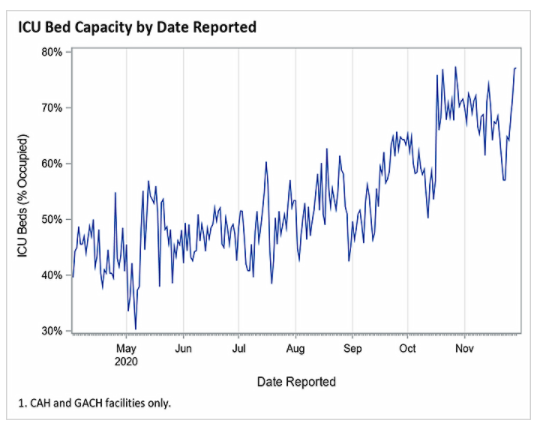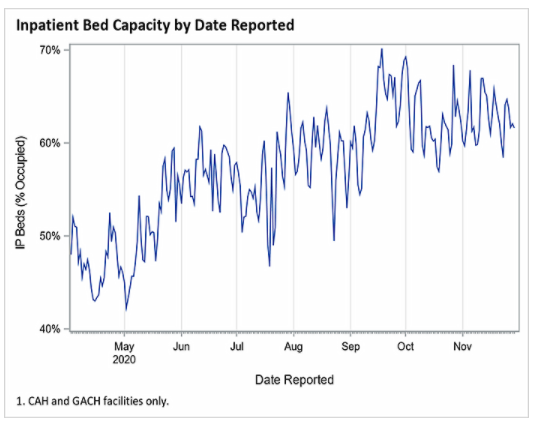Are you looking for a shipping solution? Maybe you need to change freight carriers? Find out what the hard working and reliable people at Team Worldwide can do over land, sea and air
Alaska Department of Health & Social Services COVID-19 Weekly Case Update
November 22-28, 2020
Brief status report
- Virus transmission across Alaska is estimated to have increased for the ninth week in a row.
- Cases diagnosed in recent weeks have exceeded the ability of public health to immediately report individual cases. Cases reported this week are an underestimate of true new positive tests. New positive tests are always an underestimate of true new cases.
- Hospitalizations for COVID-19 continue to rise. Hospital capacity and staffing have become a significant concern.
- Testing is not keeping up with new cases.
- Alaskans should get tested immediately at the first sign of any symptoms. Testing is our best tool for understanding virus transmission and risk in our communities.
- Most Alaskans get COVID-19 from a friend, family member or coworker. Alaskans should avoid indoor gatherings with non-household members, avoid crowds, wear masks when around non-household members and stay six feet from anyone not in their household.
- Travel is currently a high risk activity. This week, around 1 in 16 passengers tested after arriving at Alaska airports from out of state were positive for the virus causing COVID-19.
Case trends and predictions
- Over four thousand cases among Alaskans were reported last week, reflecting continued high community transmission throughout much of Alaska.
- Cases are increasing across urban and rural regions and increased in nearly every region this week. All regions of Alaska have high community transmission and are at a high alert level.
- The estimated daily growth rate is 1.7% and cases are expected to double around every 42 days based on current modeling.
- The largest increases in case rates were in the Mat-Su Borough and Yukon-Kuskokwim Delta Regions. Mat-Su, which had reported a decline in case rates last week, had an increase in 14-day case rate per 100,000 from 41.7 to 68.3, a 64% rise. The Yukon-Kuskokwim Delta Region continued a trend of steep increase in case rate from 146 to 188, a 29% rise.
- Several regions reported decreases in case rates, including a small decrease in Anchorage as well as larger decreases in Fairbanks, the Interior, Juneau and both Southeast regions. Anchorage’s positivity rate of 6.9 suggests that the case rate in Anchorage is likely a significant underestimate, while a positivity rate lower than 5% in the other regions suggest that undertesting is less of a concern. Anchorage continues to have a case rate reflective of an extremely high incidence of community transmission, at a 14-day average case rate of 105 cases per 100,000 people.
- Put in real terms and using Anchorage as an example, a model developed at Georgia Tech estimates that a gathering involving 10 people in Anchorage right now would have more than a 4 in 10 chance of including at least one person with COVID-19. Model: https://covid19risk.biosci.gatech.edu/
Vaccine planning and status update
- The State of Alaska is working with federal, local, Tribal and military partners to ensure that infrastructure is in place for distribution of vaccine as soon as it is available.
- Vaccine will be distributed as soon as it is received. A limited amount of vaccine will be available at first with more expected to be delivered in the coming weeks and months.
- Recent announcements by several companies testing COVID-19 vaccines have shown promising safety and efficacy data, including over 90% efficacy for two of the vaccines. The companies said they will pursue FDA authorization and one has already submitted their data. One or more vaccines may obtain authorization from the FDA within weeks if they pass review by the FDA and a board of independent experts, who will review all trial data.
- If authorized by the FDA, the first shipments of vaccine could be available as early as mid-December.
- There are no plans to mandate a vaccine at the state level.
- People at high risk of getting exposed to COVID-19 or of getting very sick may be vaccinated first.
- ACIP and other groups will provide more details as more data comes out from clinical trials, and states, Tribes and organizations may provide their own guidance to tailor distribution to Alaska’s needs.
- During the week of November 22-28, 4,317 new cases in Alaskans were reported, a 10% increase from last week, for a total of 31,323 cumulative cases in Alaskans.
- Cumulative hospitalizations increased to 710 with 47 reported as occurring this week, nearly double last week’s total new hospitalizations. Hospitalization reports often lag and only 600 hospitalizations were reported at this time last week, so there are 110 hospitalizations newly reported this week including ones that began during previous weeks.
- Deaths among Alaska residents increased by 18 to 120 total. One of the reported deaths occurred this week and the other 17 occurred prior to the past week. It is common to take more than a week for a death to be reported, and more deaths of Alaskans with COVID-19 occurring Nov 22-28 may be reported in future.
- There were 67 nonresident cases identified this week, for a total of 1,253.
How COVID-19 spreads in Alaska
- Most new infections among Alaskans are from community spread, not from travel. Most Alaskans get the virus from someone they work, socialize, or go to school with.
- Many cases do not have a clear source, meaning that contact tracers have not been able to identify where the person got the virus. This means that there are cases in our communities that we do not know about.
- Many Alaskans who are diagnosed with COVID-19 report that they went to social gatherings, community events, church services and other social venues while they were contagious but before they knew they had the virus.
Positivity rates
- The statewide test positivity rate improved from 8% to around 6.4% this week.
- Currently, the national average is 9.6%, up from 4.2% in October. Source: Johns Hopkins
- Test positivity can tell us if testing is adequate in an area. The goal is a positivity rate <2%. If the rate is over 5%, it means we are likely missing a lot of cases in that area.
- Test positivity is affected by the number of tests performed as well as the number of new cases in an area.
- Hospitalizations hit record highs for the sixth week in a row.
- Currently, 182 Alaskans with confirmed COVID-19 are hospitalized, an increase of 42% from last week. 41 are requiring a mechanical ventilator, which is 22 more than last week, an increase of 116%.
- Hospital staffing can change quickly, particularly if a community has many health workers impacted by COVID-19.
Travelers with COVID-19
- Test positivity among travelers arriving back to Alaska has increased sharply in recent weeks, following increases in case rates across the United States, meaning that a higher proportion of people on flights to Alaska have COVID-19. Currently, around 1 in 16 passengers (6.14%) tested on arrival from out-of-state to airports in Alaska have COVID-19.
- Air travel carries risk of exposure in airports, on aircraft, in taxis or rideshares and after arrival at the destination. While keeping 6 feet of distance and wearing masks will help, any gathering with others outside of the household carries some risk, particularly if it is indoors; Alaskans who are traveling to meet with friends and family may be at higher risk of acquiring the virus than Alaskans who do not gather with others.
- Alaskans must follow relevant state and local orders when traveling within Alaska and returning from out of state.
- Alaskans should avoid gatherings and crowds, wear masks when around any non-household member, keep six feet of distance from anyone not in their household and wash hands frequently to slow community transmission of COVID-19.
- Anyone with even one new symptom of COVID-19 (fever, chills, cough, shortness of breath, difficulty breathing, fatigue, muscle aches, body aches, headache, new loss of taste or smell, sore throat, congestion, runny nose, nausea, vomiting, or diarrhea), even if it is very mild, should get tested for COVID-19 right away and immediately isolate themselves from others by staying home, staying away from others, and not leaving their house except to seek testing or other medical care. Tests are most accurate in the first few days of symptoms, so testing as soon as possible after the first symptom starts is important, even if the symptom is very mild. Getting tested right away also helps contact tracers move as quickly as possible.
- Alaskans can help contact tracers work to slow the spread of COVID-19 by answering the phone promptly and providing accurate information.
- The Frequently Asked Questions webpage is often the quickest route to an answer regarding testing, travel, health mandates and other COVID-19 information.
- Please see the State of Alaska COVID-19 information page for more information about the virus and how individuals and businesses can protect themselves and others from transmission.
- For the most up-to-date case information, see the Alaska Coronavirus Response Hub dashboard. Some data may change as more information comes to light through contact tracing and other public health work.
- For questions regarding DHSS COVID response, including mandates and alerts, email [email protected].




